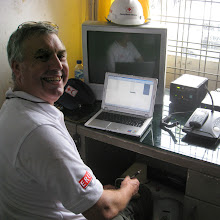
I’m spending a few days in Jakarta installing two radio systems at the Indonesian Red Cross (PMI) headquarters, one of which will allow Jakarta to communicate directly to Banda Aceh, all part of the Tsunami Recovery Project.
It was quite a shock to arrive in Jakarta, Thursday night, to discover a city of anywhere from 9,000,000 to 23,000,000 people depending whether you’re talking about Jakarta proper or great Jakarta. Either way it’s a massive population. The expressway coming into town from the airport, albeit later in the evening, flowed well and we got to the hotel quickly. Friday was totally different. Jakarta is known for its major traffic problems and I got to see it first hand as we slowly worked our way to the IFRC office building.

On Saturday Sarmad and I had a few things to pick up for the radio installations on Monday and we spent a long time stuck in long lines of backed up traffic. They do have white lines dividing the road into lanes but these are largely ignored, the number of lanes is more dictated by the width of the vehicle. When we got back to the hotel one of the staff commented how lucky we were to actually make it to the places that we did on a Saturday.
Sunday was my day off so I took a taxi to try and locate the only two geocaches in Jakarta. If you haven’t heard about geocaching it’s basically a treasure hunt using a handheld GPS to locate items that have been hidden by others. It first started in May 2000, when Dave Ulmer from Portland, Oregon, hid some trinkets in the woods outside Portland posted their coordinates in a newsgroup posting and challenged people to find them. As of a few minutes ago www.geocaching.com, the center of all things related to geocaching, are reporting 752,612 caches worldwide. Better get started soon!


The first cache in Jakarta was placed within a national monument, called Monas, located at the center of the city. It’s a 450’ tall tower topped by a huge flame with a central elevator. Unfortunately, it had a very long lineup waiting to get to the top. I declined to wait in the heat and humidity, so I didn't get to answer the question that I needed to claim that cache.

The second cache is what is known as a ‘traditional’ cache located in the Tarman Prasati Museum where they have collected grave stones and monuments from all over Jakarta, one dating back to the late 15th century. The cache was a small container hidden at the base of a tree. The geocaching experience is searching for caches that take you to places with interesting features that you would not otherwise see. You then log your find's so that the owners of the caches have a record of everyone that has found it.
BTW – the Sunday traffic was much better!
In each hotel on my tour of Aceh province I found that the only TV channels available were Indonesian. But, here in Jakarta I have found channels from Australia, UK, USA, France, Germany, Italy, France, Spain, China (mainland), China (Taiwan), Hong Kong, and Japan, perhaps an indication of the international nature of this capitol city.
At the IFRC on Friday I met up with Bob McKerrow again, whom I'd first had the pleasure of meeting last week in Banda Aceh. Bob is the Head of Delegation for the IFRC in Indonesia and as such he coordinates the work of the dozens of Red Cross and Red Crescent national societies working in the country, a huge task. He’s a fascinating man with a wide range of interests and experiences. He’s also a writer and a blogger and his site is well worth a visit: www.bobmckerrow.blogspot.com. Check it out. Bob has a background in radio communication (13 months in Antarctica to name one) and has taken a keen interest in our work. He’s an avid supporter of what we’re doing so we are thrilled to have his enthusiasm on our team!


No comments:
Post a Comment